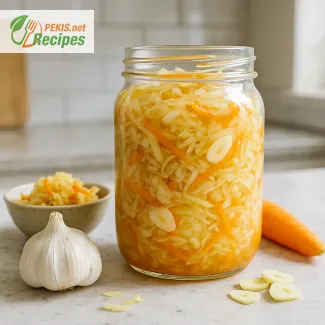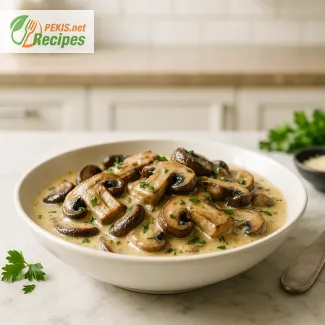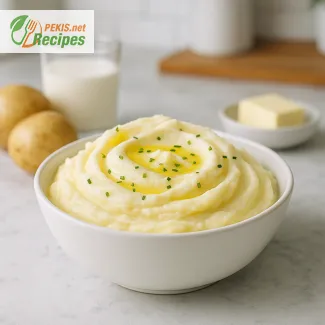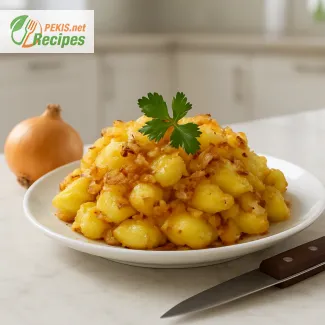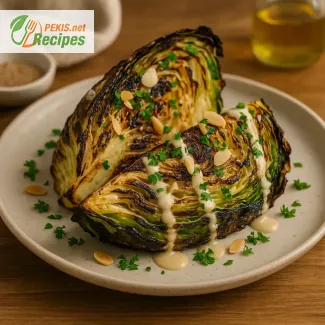
How Grilled Cabbage Became the Star of Summer Cooking
A smoky twist on a humble vegetable that elevates outdoor dining
In the world of seasonal vegetables, cabbage often flies under the radar—overshadowed by more vibrant or delicate greens. But once you discover the magic of charred cabbage, it becomes impossible to ignore its deep flavor, meaty texture, and surprising versatility. Whether tossed on a grill or seared in a cast-iron skillet, this dish delivers bold flavor, crispy edges, and a caramelized core that redefines what cabbage can be.
Charred cabbage is not just another side dish; it’s a culinary transformation. The high-heat technique draws out its natural sweetness and adds a layer of smoky complexity. Perfect for summer gatherings, weeknight dinners, or as a plant-based centerpiece, this recipe has earned its place in modern summer cuisine.
Why charred cabbage deserves a place on your summer table
From peasant food to gourmet fare: The rise of cabbage in modern cuisine
Cabbage has long been a staple in traditional cooking, valued for its affordability and long shelf life. But recently, it’s taken a new turn—emerging as a hero ingredient in restaurants, cookbooks, and social feeds alike. When grilled or charred, cabbage takes on a character that’s both rustic and refined, making it ideal for casual BBQs or elegant vegetarian menus.
Unlike steamed or boiled versions, charred cabbage offers texture and depth. The outer layers become crisp and smoky, while the inner leaves remain tender and juicy. This contrast makes each bite interesting and deeply satisfying, especially when paired with acidic dressings, creamy sauces, or umami-rich toppings like miso or tahini.
Choosing the right cabbage for grilling
The best varieties and how to prepare them for maximum flavor
Not all cabbage is created equal when it comes to grilling. Green cabbage remains the most popular choice due to its dense structure and neutral flavor profile. It holds up beautifully over open flame and develops a delicious char without falling apart. However, Savoy cabbage adds an elegant texture, and red cabbage brings vibrant color and a slightly more peppery flavor.
To prepare cabbage for grilling, it’s essential to keep the core intact when slicing into wedges. This helps each wedge stay together during cooking. Brushing the cut sides with high-heat oil and seasoning generously with salt enhances the browning process and ensures a well-balanced result.
The art of getting the perfect char
Techniques that guarantee crispy edges and smoky notes
Achieving a proper char isn’t just about tossing cabbage on a grill and waiting. There’s a fine line between beautifully blackened edges and burnt bitterness. The key lies in controlling the heat, minimizing movement, and letting each side develop color without interference.
Use direct high heat to sear the cabbage wedges quickly, then move them to indirect heat to finish cooking through. In a skillet, searing cut-side down without flipping too soon helps develop an evenly caramelized crust. Avoid overcrowding, as this traps moisture and prevents browning. Patience and timing are crucial for the best outcome.
Flavor pairings that enhance charred cabbage
Sauces, herbs, and spices that take the dish to the next level
The beauty of charred cabbage is how well it plays with other bold ingredients. A drizzle of lemon tahini, a spoonful of harissa yogurt, or a sprinkle of toasted nuts and fresh herbs can turn a humble cabbage wedge into a culinary statement. Cumin, smoked paprika, or chili oil accentuate the smokiness and add a warming contrast.
For a refreshing twist, finish with citrus zest or pickled onions, balancing the roasted flavors with brightness and acidity. Pair it with grilled tofu, roasted chickpeas, or seared halloumi for a more complete meal that’s rich in texture and plant-based protein.
When and how to serve charred cabbage
Make it the hero of the meal or a standout side
While charred cabbage can accompany anything from grilled meats to pasta, it truly shines when allowed to take center stage. Serve it as a main course topped with robust dressings and crunchy toppings, or slice it thin and use it as a smoky base for grain bowls and wraps.
It’s also ideal for meal prep. The wedges reheat well and retain their texture, making them a practical yet flavorful option for lunches throughout the week. Serve warm, at room temperature, or even chilled—it’s remarkably versatile and adapts to any course.
Charred cabbage as a plant-based meat alternative
Hearty, satisfying, and packed with natural umami
For those seeking plant-based dishes that don’t feel like a compromise, charred cabbage offers a satisfying alternative. Thanks to its chewy interior and crispy edges, it mimics some of the best traits of roasted meats—without any need for imitation products.
When marinated in soy sauce, garlic, and vinegar, or brushed with barbecue glaze, it delivers a depth of flavor that rivals traditional meat-based options. It’s ideal for flexitarians or anyone exploring more vegetable-forward meals.
Sustainability and local sourcing
Why cabbage is a smart seasonal choice for conscious cooking
Cabbage is one of the most eco-friendly vegetables to grow and transport. It’s often available year-round, but it peaks in late spring through summer, making it an excellent choice for seasonal cooking. Its minimal water needs and long shelf life make it a sustainable option for home cooks trying to reduce food waste.
Moreover, buying from local farms ensures freshness, supports regional agriculture, and cuts down on your food’s carbon footprint. Charred cabbage is not just a flavor-forward choice—it’s also a smart one for conscious consumers.
- Prepare the cabbage:
Remove any tough outer leaves from the cabbage, then cut the cabbage into 4 equal wedges, keeping the core intact in each piece so they hold together during cooking. - Season the wedges:
In a small bowl, mix the olive oil, sea salt, black pepper, garlic powder, and smoked paprika. Brush each side of the cabbage wedges generously with this mixture. - Grill or sear the cabbage:
Heat a grill or a cast-iron skillet over medium-high heat. Place the cabbage wedges cut side down and cook for 5–6 minutes on each side, or until deeply charred and tender. Avoid moving them too often to allow proper caramelization. - Prepare the tahini dressing:
In a separate bowl, whisk together tahini, lemon juice, water, maple syrup, and Dijon mustard until smooth. Adjust water for a thinner consistency if needed. - Assemble the dish:
Transfer the grilled cabbage wedges to a serving plate. Drizzle with tahini dressing. Sprinkle toasted almonds and chopped parsley over the top for crunch and freshness. - Serve:
Serve warm or at room temperature as a main dish or side. Optionally, add extra lemon juice or chili oil to enhance brightness and heat.
Elevate Your Cabbage Game: Smart Tweaks for a Smokier, Bolder Dish
Expert techniques and ingredient swaps to unlock new dimensions of flavor
When it comes to grilled or charred vegetables, few ingredients surprise more than cabbage. But while the classic approach of simply charring seasoned wedges yields wonderful results, a few thoughtful enhancements can turn this humble side into a standout culinary centerpiece. Whether you're aiming for deeper flavor, a healthier twist, or a more vibrant presentation, improving the traditional charred cabbage recipe is about embracing balance, contrast, and technique.
Boosting flavor with marinades and spice rubs
While a simple seasoning of salt, pepper, garlic powder, and smoked paprika already gives the cabbage a savory kick, marinating the wedges for 15–30 minutes before grilling can enhance complexity. A mixture of soy sauce, lemon juice, olive oil, and crushed garlic infuses each layer with umami depth and brightness.
Alternatively, dry rubs using cumin, coriander, chili flakes, or even fennel seeds bring a punchy aromatic lift. These combinations allow the cabbage to stand out even when served alongside heartier mains. For a spicier profile, a dash of chipotle powder or Gochugaru adds subtle heat without overwhelming the natural sweetness of the vegetable.
The case for homemade sauces: more control, better nutrition
The tahini dressing commonly paired with charred cabbage offers creamy richness and tang. Making it at home instead of using a store-bought version allows for customization: adding roasted garlic, a splash of apple cider vinegar, or a touch of Greek yogurt creates a silkier, lighter finish. Swapping maple syrup with date syrup or honey can also provide alternative sweet profiles, depending on dietary preference.
For those seeking a dairy-based dressing, a simple lemony yogurt sauce or buttermilk herb drizzle works beautifully, especially in warmer months. These sauces enhance freshness and complement the smokiness of the cabbage without masking its core flavor.
Healthier fats and smart roasting oils
Although olive oil remains a top choice for grilling, switching to avocado oil can increase the smoke point, making it better suited for high-heat cooking. Avocado oil also adds subtle buttery notes and heart-healthy fats. For a unique spin, try sesame oil in moderation—it brings nutty depth, particularly if the dish leans into Asian-inspired flavor profiles.
Avoid using low-smoke-point oils like flaxseed or unrefined sunflower oil, which can break down at high temperatures and impart bitter tones.
Add texture and protein with toppings
To create a more nutritionally complete meal, think beyond garnishes. While toasted almonds provide crunch and visual appeal, mixing in roasted chickpeas, crisped tempeh, or seared halloumi adds both protein and substance. These ingredients pair well with the earthiness of cabbage and contribute to satiety without resorting to meat.
For additional texture, consider sprinkling crispy shallots, toasted seeds (like pumpkin or sunflower), or even puffed quinoa on top. These not only elevate the plating but also offer satisfying contrasts in every bite.
Improve balance with acidity and herbs
Cabbage’s natural sweetness intensifies when charred, so introducing acidity helps create balance. Besides lemon juice, experiment with sherry vinegar, rice vinegar, or a splash of fermented pickle brine. These lift the dish and cleanse the palate, especially when served with richer accompaniments.
Fresh herbs like cilantro, mint, dill, or tarragon add bursts of freshness. Herbs should be added right before serving to preserve their color and aromatics. A final zesting of lemon or orange peel provides essential oils that brighten the overall profile.
Why home-cooked beats store-bought or restaurant options
Preparing this dish at home gives full control over ingredients, portion sizes, and dietary adjustments. You can choose organic cabbage, monitor salt content, and tailor each component to fit your taste or nutritional needs. Store-bought versions or restaurant adaptations often rely on added sugars, processed fats, or excessive sodium.
Moreover, home preparation allows you to grill or sear cabbage to exact preference—some enjoy deeply charred edges for a smoky crunch, while others prefer milder caramelization with soft centers. Adjusting the heat, time, and pan vs. grill options can drastically shift the final texture.
Common pitfalls and how to avoid them
One of the most frequent mistakes in preparing charred cabbage is overcrowding the pan or grill, which leads to steaming instead of searing. Always leave space between wedges to allow for dry heat contact. Undercooking is another issue—cabbage that is only charred on the outside but raw in the center lacks the satisfying texture contrast.
Another mistake is using too little oil, which causes sticking and uneven browning. However, using excessive oil can drown the cabbage and create a soggy result. A light brush is best.
Skipping seasoning or forgetting acid at the end can leave the dish tasting flat. A final touch of salt and citrus wakes up all the other flavors.
Exploring colorful and seasonal variations
For a visual upgrade, try red cabbage, which chars beautifully and holds its vivid magenta hue after cooking. It tends to be slightly denser and more peppery than green varieties, making it ideal for pairing with sweet glazes or creamy dressings.
In autumn or winter, adding slices of apple, pear, or roasted squash can turn this into a warming seasonal salad. In spring or summer, pair it with fresh peas, radishes, or a drizzle of mint yogurt for a cooling effect.
These tweaks transform charred cabbage from a rustic side into a dynamic and customizable dish for any occasion. Whether you’re a seasoned plant-based cook or just exploring new vegetables, the opportunities to enhance this dish are as varied as they are flavorful.
Allergens present in the recipe:
- Sesame (tahini)
- Mustard (Dijon mustard)
- Tree nuts (almonds)
Contains no gluten.
To eliminate allergens:
- Replace tahini with sunflower seed butter for sesame allergy.
- Use plain yogurt or coconut yogurt as dressing base instead of tahini-mustard combo.
- Omit almonds or replace with roasted pumpkin seeds for nut-free version.
- Use a mustard-free vinaigrette if sensitive to mustard.
Vitamins and minerals per serving (approximate):
- Vitamin C: 45 mg – supports immune system and skin health
- Vitamin K: 100 µg – essential for blood clotting and bone strength
- Folate (B9): 80 µg – crucial for DNA synthesis and red blood cell production
- Calcium: 60 mg – important for strong bones and teeth
- Potassium: 400 mg – helps maintain normal blood pressure and muscle function
- Magnesium: 40 mg – supports nerve and muscle function
Antioxidants per serving (approximate):
- Sulforaphane (from cabbage): 15 mg – helps reduce oxidative stress and supports detoxification
- Lignans (from tahini): 8 mg – known for hormone-regulating and anti-inflammatory properties
- Vitamin E (from olive oil and almonds): 2 mg – protects cells from damage and supports immune function
